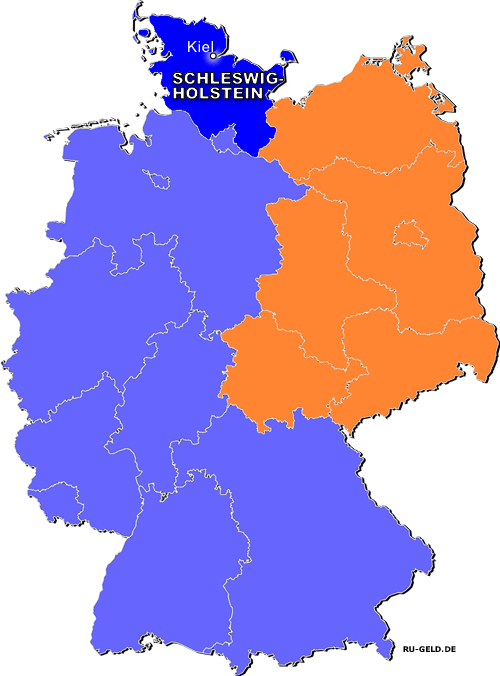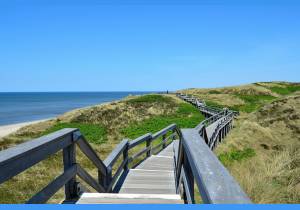German federated state of Schleswig-Holstein: characteristics, population, photos, major cities, climate, map and much more
On this page you will find interesting information, statistics about Schleswig-Holstein: major cities and the capital of the federated state, population, map, climate and weather, flag, coat of arms, photos of sightseeing attractions, ZIP code, phone codes and much more.
§ Brief overview of the Schleswig-Holstein federated state
Schleswig-Holstein (in German: [ˈʃleːsvɪç ˈhɔlˌʃtaɪ̯n]) is the northernmost federated state of Germany, bordering Denmark; in the north it is washed by two seas: from the north-west – by the North Sea (in German: Nordsee) and from the north-east – by the Baltic Sea (in German: Ostsee). The whole of the federated state is located in the North German Plain or Northern Lowland, which determines its flat landscape, the absence of mountains; these are mainly fields, lakes and one part of the land is swampy. In this federated state you will find the Bungsberg (in German: Bungsberg) elevation, the highest point with a maximum height of just over 150 meters above sea level. On the coast of the Baltic Sea there is the Holstein Switzerland Nature Park (in German: Holsteinische Schweiz) - a non-mountainous terrain with many lakes. The most famous lakes of Schleswig-Holstein are: the Plöner lakes: the Großer Plöner See ("Great Plön Lake") or Lake Plön (in German: Großer Plöner See), the Kleine Plöner See (in German: Kleiner Plöner See), the Trammer-See (in German: Trammer See), the Behler See (in German: Behler See), the Dieksee (in German: Dieksee) and others. Strong winds blow in Schleswig-Holstein and it rains a lot here. Wind farms (in German: Windenergieanlagen, WEA, Windpark) have been built everywhere, both on land and in the seas, to generate electricity from wind power. There are two large cities in this federated state: Lubeck (in German: Lübeck) and Kiel (in German: Kiel), both cities are located on the coasts of the seas. Besides, several islands located near the German coast belong to this federated state.
The major drivers for the Schleswig-Holstein economy are: shipbuilding, seaports and warehouses, fishing, tourism and, of course, wind power plants.
The sightseeing attractions in Schleswig-Holstein
The federated state tourist attractions include: the water Glücksburg Castle (in German: Schloss Glücksburg), the Hedeby archaeological complex of the ancient Vikings (in German: Haithabu),the medieval city gate of Lübeck Holstentor (in German: Holstentor), the Heligoland archipelago or Helgoland (in German: Helgoland) and the Lange Anna (in German: Lange Anna) rock formation, the Kiel Canal (in German: Nord-Ostsee-Kanal), as well as the isles of Sylt (in German: Sylt), Amrum (in German: Amrum), Föhr ( in German: Föhr), Fehmarn (in German: Fehmarn) and numerous fjords, bays, beaches and rocky coasts.
§ Photos of the sightseeing attractions in the Schleswig-Holstein federated state
To enlarge and view the picture, click on it pressing the mouse button.
-

The water Glücksburg Castle
-

The medieval city gate of Lübeck - Holstentor
-

The Heligoland archipelago or Helgoland
-

The Lange Anna rock formation, Heligoland
-

The lighthouse on the Isle of Sylt
-

The Isle of Sylt, Schleswig-Holstein
-

The City of Lübeck, architecture
-

The folding bridge in the city of Kiel
-

Holstein Switzerland
-

Wind farms, the North Sea
§ Population of the Schleswig-Holstein federated state
The population size in Schleswig-Holstein totals 2'881'926 people. Of these, 1'412'665 are men, which is 49.0 % and 1'469'261 are women or 51.0 % of the whole federated state population. The population density of the Schleswig-Holstein federated state is 182 people per 1 square kilometer.
Based on the data in Table 1 (see below on the page), the Schleswig-Holstein federated state occupies 4 % of the entire territory of Germany, which is home to 3 % of the population of the entire country, they live in 1'106 settlements located on the territory of the said land.
§ Climate and weather in Schleswig-Holstein
Like in other parts of the country, Schleswig-Holstein has a temperate climate with warm summers and relatively warm winters. According to the German Weather Service (aka the German Meteorological Service) (in German: DWD), in 2023 the average annual temperature in Schleswig-Holstein was 10.3 degrees Celsius, while in winter the air temperature was on average 3.6 °C, and in summer 17.3 °C. The rainfall in 2023 was 1'028 l/m2, and the sun shone that year in Schleswig-Holstein for 1'747 hours. Click here for more information about the Climate of Germany
§ Capital of the Schleswig-Holstein German federated state
The capital of the Schleswig-Holstein federated state is the City of Kiel, in German Kiel or Kiel, Landeshauptstadt, with a population of more than 248'000 people.
§ Statistics, essential data about the federated state
Table 1 below presents statistics as to the data for the federated state of Schleswig-Holstein, as well as indicators for the whole of Germany for comparison. Besides, from Table 1, you will learn the percentage ratio of the indicator for the federated state to the indicator for the whole of Germany.
Table 1. Statistical data on the Schleswig-Holstein federated state as of early 2017.
| Descriptor | Value as to the federated state and its percentage ratio to the indicator for the whole of Germany | Value for the whole of Germany | |
|---|---|---|---|
| Name in German | Schleswig-Holstein | - | - |
| Federated state type designation, in German | Land | - | - |
| Abbreviation (code) of the federated state, in German | SH | - | - |
| Capital of the federated state | Kiel (нем. Kiel) | - | - |
| Territory, land area | 15'802 km2 | 4 % | 357'578 km2 |
| The federated state population, all people altogether | 2'881'926 | 3 % | 82'521'653 |
| The federated state population, men | 1'412'665 | 3 % | 40'697'118 |
| The federated state population, women | 1'469'261 | 4 % | 41'824'535 |
| Population density, people per km2 | 182 | 79 % | 231 |
| Number of administrative districts (in Ger .: Bezirk) | 0 | 0 % | 19 |
| Number of counties (in Ger.: Kreis) | 15 | 4 % | 401 |
| Number of cities of regional subordinance, i.e. district-free cities or urban districts (in Ger.: kreisfreie Städte) | 4 | 4 % | 107 |
| Number of the federated state rural districts (in Ger.: Landkreis) | 11 | 4 % | 294 |
| Number of municipalities (in Ger.: Gemeinde), i.e. localities or settlements | 1'106 | 10 % | 11'042 |
| Number of cities | 63 | 3 % | 2060 |
§ The Schleswig-Holstein federated state holidays schedule
Every federated state in Germany has the right to establish holidays, days off from work, which are valid on their territory. On the territory of Schleswig-Holstein there are 12 official holidays. A detailed calendar of the Schleswig-Holstein federated state public holidays can be found on a dedicated page of our website. The school vacations schedule of the Schleswig-Holstein federated state is also established by a decision of the local government distinct from other German federated states.
§ Major cities in the Schleswig-Holstein federated state
In the Schleswig-Holstein federated state there are 1'106 settlements, of which 63 are cities. Table 2 below contains a list of major, large cities in the said federated state.
Table 2. Major cities in the Schleswig-Holstein federated state in English and German.
| Nr. | Name of the city | Name of the city in German | Population size, rounded to thousand people |
|---|---|---|---|
| 1 | Kiel (Capital of the federated state) | Kiel | 248'000 |
| 2 | Lübeck | Lübeck | 219'000 |
| 3 | Flensburg | Flensburg | 93'000 |
| 4 | Norderstedt | Norderstedt | 82'000 |
| 5 | Neumünster | Neumünster | 80'000 |
| 6 | Elmshorn | Elmshorn | 51'000 |
| 7 | Pinneberg | Pinneberg | 45'000 |
| 8 | Wedel | Wedel | 35'000 |
| 9 | Ahrensburg | Ahrensburg | 35'000 |
| 10 | Geesthacht | Geesthacht | 33'000 |
| 11 | Itzehoe | Itzehoe | 33'000 |
| 12 | Rendsburg | Rendsburg | 30'000 |
| 13 | Reinbek | Reinbek | 29'000 |
| 14 | Schleswig | Schleswig | 26'000 |
| 15 | Bad Oldesloe | Bad Oldesloe | 25'000 |
| 16 | Husum | Husum | 24'000 |
| 17 | Kaltenkirchen | Kaltenkirchen | 24'000 |
| 18 | Quickborn | Quickborn | 23'000 |
| 19 | Heide | Heide | 23'000 |
| 20 | Eckernförde | Eckernförde | 22'000 |
§ Flag and coat of arms of the Schleswig-Holstein federated state
In the picture below, you can see the flag or flag / coat of arms of the federated state.

§ Schleswig-Holstein on a map of Germany
In the picture below, you can see the location of the federated state and its capital on a map of Germany. Map of all the federated states of Germany and their capitals.

- Information about Germany
- All about Germany and the Germans - a general description of the country
- Administrative and territorial structure of Germany
- National symbols of Germany: flag, coat of arms, anthem, buildings, mottos and others
- Federated states of Germany and their capitals in German and English
- Political structure of Germany: parties, elections, authorities, policy
- Germany budget: structure, revenues and expenditures
- Climate and weather in Germany
- List of all German cities ordered alphabetically in English and German









